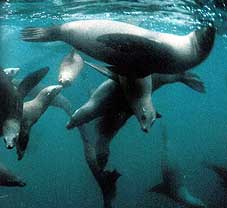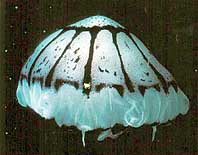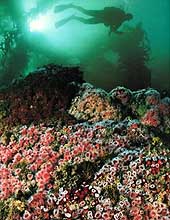






















|

The Tides of Monterey Bay
Monterey Bay, a notch in the central coast of the American
state of California, is only 32 kilometres across. On a clear day, from
Cannery Row (that spot on the shores of the Monterey Peninsula, which author
John Steinbeck made famous in his 1945 novel by the same name), one can almost
make out Santa Cruz on the other side. What you cannot see is a vast chasm on
the scale of Grand Canyon that cuts through the center of the bay, bringing
countless denizens of the deep sea within a few hundred meters of shore. This
Monterey Canyon also provides a well of cold, deep water, rich in nutrients
that accumulate from the detritus of organisms above.
 Herd
of California sea lions Herd
of California sea lions
The upwelling once fed the regionís famous canneries
until, over-fished, they vanished after World War II. It also encourages the
growth of great kelp forests - algal jungles teeming with fishes and mollusks,
crustaceans and sea otters. This bounty still lures millions of sea birds from
rookeries across the Pacific Ocean. It is here that herds of California sea
lions swim offshore. In April and May they swim to southern California to
breed in the Channel Islands. Each season, grouped into pods of 100-200, these
sea lions migrate back to the Pacific waters off the shores of Monterey.
 Purple
striped jellyfish Purple
striped jellyfish
Onshore, the bayís tempering winds foster a climate ideal
for wintering monarch butterflies, or for growing the countryís best
Brussels sprouts. But mostly Monterey Bay is a poem of the sea; a complex
dream with internal rhythms that confound and astonish. Jostling for room, sea
anemones, corals and sponges vividly span the floor of an ocean forest. The
water is rich enough to supply great numbers of filter feeders, and
competition for space is intense. The upwelling of nutrients released from
dead plants and animals is the key to the bayís fecundity. From March to
October, winds from the northwest help deflect surface waters of the cold,
south-flowing California Current, and deep water rises to fill the void. The
Monterey Canyon acts as a funnel to bring the deep, rich water to the surface.
The pea soup of plankton clears when the winds weaken in
fall. This is the season for scuba diving. In January, the bay feels the
warming influence of the north-flowing Davidson Current. This watery region is
a meeting of subtropical and temperate zones. Here a marine biologist or
sports diver will get to see more life than in either region alone, and it is
the richest ecosystem on Americaís West Coast.
 Competing
for space; coral, anemones, and sponges growing on the floor of the Monterey
Canyon Competing
for space; coral, anemones, and sponges growing on the floor of the Monterey
Canyon
A new era of exploration and intensified study of marine
life was introduced when the Monterey Bay Aquarium opened in 1984, and by the
establishment of the Monterey Bay Research Institute (MBARI) in 1987. The
canyon beneath the bay provides unique conditions which creat a habitat
ideally designed in which to study marine life. If the bay were to be drained,
a landscape comparable to Arizonaís Grand Canyon would emerge. The largest
submarine chasm along the continental USA, the Monterey Canyon plunges to 300
feet just a kilometre offshore, and meanders some 175 kilometres out to sea to
depths of more than three kilometers.
Carved from granite, shale and sandstone, the canyon was
born 25 to 30 million years ago, nearly 300 kilometres to the south. Pushed
along the San Andreas Fault as part of the Pacific plate, it owes much of its
magnitude to continual seismic activity - from tremors to major earthquakes -
that triggers erosion. Unmanned, remotely controlled underwater exploration
vehicles have opened the canyon to sustained exploration. Monterey Bay is a
microcosm of the open ocean. It is big enough to be an intellectual challenge,
but small enough to grasp, physically and mentally.
Itís that time again!
by Lesley Warner
A friend of mine asked me to accompany her on a visa run
the other day to Cambodia, and I thought, why not? Itís a trip that I
havenít done for while. As a lone farang woman itís sometimes nice to go
with a friend, as we seem to be outnumbered by our male friends.
When your visa expires you must renew by leaving the
country; if you have a multiple entry ĎBí visa you can renew for 3 months,
if not you can renew for 1 month. (You can get an extension of your visa at
immigration in Soi 8 but this is only for 2 weeks. If you are unsure of the
regulations ask at Immigration - they are very helpful).
We chose A1 Visaís (01 344 4721) as they came highly
recommended, I had used them before and knew them to be efficient, friendly
and inexpensive. Another benefit with A1 is that they collect you from your
accommodation and at the unearthly hour of 4.30-5.00 a.m. you donít feel
much like driving.
We settled into the comfortable air-conditioned mini-bus
and went to sleep until our first stop at about 8.30 a.m. when we stopped at a
roadside restaurant that served traditional Thai dishes and more importantly
for me, coffee.
Then it was back into the bus and on to the border town of
Aranyaprathet. We arrived at 10 a.m. I was amazed at the change in the place
(itís been some time since I was last there); it was hardly recognizable. A
proper car park had been constructed with allocated parking spaces and
everything was being cleaned up and organized. The new entrance into Cambodia
is indeed very impressive. Unfortunately the children are still there which I
find difficult to cope with. I feel that these are kids that could really do
with some help but a word of warning, donít give in until you get back into
the bus to go home, or you will be surrounded!
We made our way to the bridge, there are 4 check points:
one before you cross over, two over in Cambodia and one on the way back. A1
make it very easy and there is someone to accompany you at all times to assist
with the paper work, and in about 30 minutes we were back and ready to board
our bus.
Another word of warning: you can buy cigarettes in Cambodia
at very cheap prices but DO NOT buy more than 200, as the penalty is very
expensive and they do check!
Then it was back home, with a short stop at the same
roadside restaurant and we were back in Pattaya by 3.30 p.m. in the afternoon.
Phi Ta Khon
by Suchard Krephitmai
We all love a good ghost story. The spiritual and the
supernatural, even the gruesome arouse an instinctive curiosity in all of us.
In the west, we have Halloween on October 31. In Thailand, the spirit world
comes closest to us in June 23-24, 2001 with the Phi Ta Khon Festival; an
event filled with fun, mischief and of course, a touch of the unknown.
This festival, unique to Thailand, is held in the Dan Sai
District of Loei Province, about 450 km north of Bangkok. Phi Ta Khon is part
of a Buddhist merit-making holiday known locally as ĎBun Pha Ves.í The
precise origin of Phi Ta Khon is not clear. But itís believed that the roots
of the festival revolve around an important tale of the Buddhaís last life,
before he reached nirvana.
According to Buddhist folklore, the Buddha-to-be was born
as Prince Vessandorn, a generous man who gave freely to the people. Then one
day he gave away a white elephant, a royal creature, worshipped as a symbol of
the rain. This made the people in the town very angry, as they feared reprisal
of drought and famine, so they banished the prince into exile.
The prince left the village for a long time and went on a
very long journey. Finally, the king and the people relented and recalled him
to the city. When he eventually returned, his people were overjoyed. They
welcomed him back with a celebration so loud that even the dead were awakened
from their slumbers to join in the festivities.
Phi
Ta Khon is held with the arrival of the sixth or seventh lunar month, when the
young male villagers prepare their ghostly attire and masks, while children
roam around town playing tricks. Sheets or blankets are sewn together to look
like shrouds while traditional wooden bamboo containers used to store sticky
rice (huad), are creatively fashioned into bizarre hats. The huge masks are
carved from the bases of coconut trees. The spirit masks are the integral part
of the celebrations, which lasts for three consecutive days.
On the first day there is a masked procession with music
and dancing. On the second day, the villagers dance their way to the temple
and let off bamboo rockets to signal the end of the procession. As the parade
travels through the street they tease and play with the on looking crowd as
they accompany a sacred image of the Buddha. Monks recite the story of the
Buddhaís last incarnation before attaining enlightenment.
The festival organizers also hold contests for the best
masks, costumes and dancers, and plaques are awarded to the winners in each
age group. The most popular event is the dancing contest among those dressed
up as ghosts. On the last day of the event, the villagers gather at the local
temple, Wat Ponchai, to listen to the message of the thirteen sermons of the
Lord Buddha, recited by the local monks. Everyone is welcome to join in.
The ghost dancers then put away their ghostly masks and
costumes for another year and itís back to the rice field to continue to
earn their living with the onset of the new crop season.
Updated every Friday
Copyright 2001 Pattaya Mail Publishing Co.Ltd.
370/7-8 Pattaya Second Road, Pattaya City, Chonburi 20260, Thailand
Tel. 66-38 411 240-1, 413 240-1, Fax: 66-38 427 596
Updated by
Chinnaporn Sungwanlek, assisted by Boonsiri Suansuk.
E-Mail: [email protected]
|
|